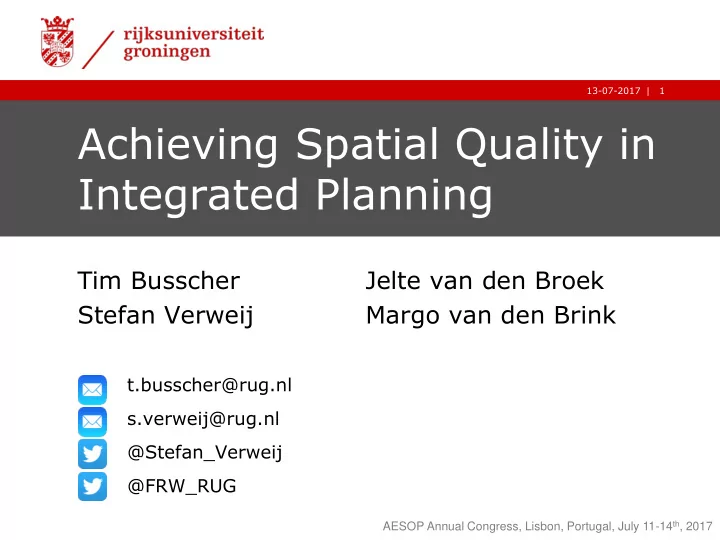

S 13-07-2017 | 1 13-07-2017 | 1 Achieving Spatial Quality in Integrated Planning Tim Busscher Jelte van den Broek Stefan Verweij Margo van den Brink t.busscher@rug.nl s.verweij@rug.nl @Stefan_Verweij @FRW_RUG AESOP Annual Congress, Lisbon, Portugal, July 11-14 th , 2017
13-07-2017 | 2 Room for the River › An Evaluation of the Dutch ‘Room for the River’ Program Using Qualitative Comparative Analysis Source: Http://www.ruimtevoordewaal.nl
13-07-2017 | 3 Room for the River: Background › The 34 projects in the Room for the River program Source: Ruimte voor de Rivier (2016a)
13-07-2017 | 4 Room for the River: Background Source: Ruimte voor de Rivier (2016b)
13-07-2017 | 5 Research Aims › Assessing the extent to which the Room for the River program has been able to achieve the spatial quality objective › Identifying the context conditions and instruments that are effective in achieving spatial quality › Research commissioned by Rijkswaterstaat (Ministry of Infrastructure and the Environment)
13-07-2017 | 6 Data and Method › Data: Archives of the Room for the River program management Small survey amongst project managers › Cases: 20 projects in the Room for the River program › Method: Qualitative Comparative Analysis (QCA)
13-07-2017 | 7 The Room for the River Program › Analyzing program theory of Room for the River with QCA
13-07-2017 | 8 QCA in a Nutshell (1/3) › Step 1: Calibration Transforming raw qualitative/quantitative data to case scores of 0.0 ≤ x ≤ 1.0 This results in a calibrated data matrix › Step 2: Constructing Truth Table › Step 3: Minimizing Truth Table
13-07-2017 | 9 QCA in a Nutshell (2/3) › In the calibrated data matrix, each row is a case › In the truth table, each row is now a logically possible configuration of conditions and each case is assigned to the configuration it belongs to Data Matrix Truth Table
13-07-2017 | 10 QCA in a Nutshell (3/3) # › Truth table minimization: pairwise comparison of truth table rows that have the same outcome and differ in but one condition A{1}*B{0} Y{0}
13-07-2017 | 11 Results (1/2) › Effective configurations of instruments in planning phase › Path 1: Program-as-guardian strategy › Path 2: Project-as-driver strategy › Path 3: Going-all-in strategy
13-07-2017 | 12 Results (2/2) › Effective configurations of instruments in realization phase › Paths 4,8: Going-all-in strategy › Path 5: Laissez-Faire strategy › Paths 1,2,6: Maintenance strategy › Paths 3,7,9: Contract strategy
13-07-2017 | 13 In Conclusion › The Room for the River: Frontrunner in area oriented planning and integrated water management › Spatial quality was achieved in project plans (planning phase) in 11/23 projects (48%) Three strategies (combinations of instruments) were effective › Spatial quality had improved compared to baseline (realization phase) in 20/23 projects (87%) Four strategies were effective › QCA Novel method, recently introduced in research on Spatial Planning (Verweij et al., 2013) and Water Management (e.g., Huntjens et al., 2011) Well-suited to systematically and comparatively analyze a medium-n of cases in order to identify conditions that explain a certain outcome of interest
13-07-2017 | 14 Referenced Sources › Huntjens, Pahl- Wostl, Rihoux, … Nabide Kiti (2011). Adaptive water management and policy learning in a changing climate: A formal comparative analysis of eight water management regimes in Europe, Africa and Asia. Environmental Policy and Governance , 21(3), 145 – 163. › Ruimte voor de Rivier (2016a). Ruimte voor de rivier: Samen werken aan een veiliger en mooi rivierengebied. Ruimte voor de Rivier. › Ruimte voor de Rivier (2016b). Dutch water programme Room for the River. Ruimte voor de Rivier. › Verweij, Klijn, Edelenbos & Van Buuren (2013). What makes governance networks work? A fuzzy set qualitative comparative analysis of 14 Dutch spatial planning projects. Public Administration , 91(4), 1035 – 1055. › Website: http://www.ruimtevoordewaal.nl
Recommend
More recommend